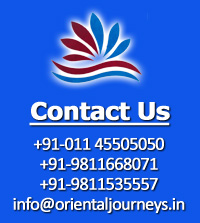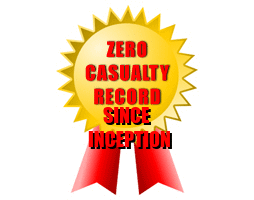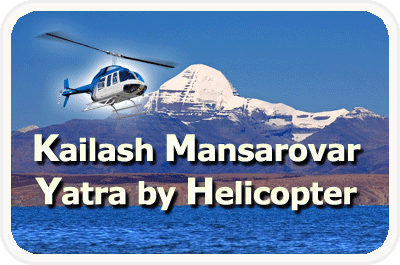Visa & Documentation
All foreign nationals willing to undertake Kailash Mansarovar Yatra including Indians require a VISA to enter Tibet. One must be in possession of a valid passport for another six months to obtain Chinese VISA. We will require a scanned copy of your passport at the time of booking the trip which should be at least 45 days in advance). In case of Indian passport holders, we shall require original passport in New Delhi approx. 15 days prior to groups arrival date in Kathmandu so as to apply for the group VISA in India however passports of Foreign nationals shall be required in Kathmandu itself as their VISA shall be applied in Kathmandu Chinese Embassy in Kathmandu issues VISA only on Monday, Wednesday and Friday. Please note that Chinese Embassy in New Delhi accepts VISA applications between 1030 - 1130 hrs. from Monday to Friday (excluding holidays). The VISA is not stamped on your passport rather it will be on a separate piece of paper issued by Chinese Embassy because it shall be a Group VISA.
Accommodation
Kailash Mansarovar Yatra falls probably in the worlds most remote part. Most of the times, you would be away from modern civilization. One must be well equipped and self-contained. The group shall be staying in best available guest houses.Guest house accommodation wherever available will be very simple with a cozy room (dormitory at most of the places) with common bathrooms and toilets. Hot water will be provided in every room for refreshing and for drinking by our Sherpa team.
Food
The food will be supplied from our side while in Tibet including breakfast, lunch & dinner with occasional tea break. While in guest houses, meals would be served to you in our dining tent. This tent also serves as our meeting place & living hall. Toilet tents will be put up near the guesthouse, wherever feasible. Bed tea will be served in your guest house with a wake-up call. Hot breakfast will be set at dinning tent. Once Sherpa team pack-up their equipment, please get one thermos flask filled with hot water for en-route journey and then you'll move to your next destination. A light packed lunch will be served on the way. The food will be very simple and pure vegetarian.
Transportation
Transportation in Nepal and Tibet shall be by A/c buses however from Hor Qu Information center onwards, the guests shall travel by Eco Friendly battery operated buses.
During the Kailash Parikrama, we will provide Yaks to carry the camping & your personal heavy gears (one bag per person only). A Yak or Poly can be hired for you to ride on direct payment basis. (Yaks are not well domesticated and trained to ride on it).
Guide/ Escort
A Tibetan/ English speaking guide will escort the group throughout the trip including few Nepali staffs for the camping.
Clothing&Accessories
Tibet is a dry cold country as such weather may change unexpectedly at any time. Plan your clothing in a way that you can wear layers of clothes. Depending upon the season, during June, July, August till September, day time will be pleasant and quite warm with about 15-20 degree Celsius, during afternoon time 1-4 pm can be windy. The morning and evening will be chilly between minus 2 to 0 degree Celsius. We recommend to carry one warm thick pull-over, one thin pull-over, two warm pants, two light loose cotton pants, one warm windproof cotton jacket, four cotton sleeve T-shirts, two thermal under pants, two thermal vests, one rain coat, one pair each of light tennis shoes & light rubber sandal, six pairs of warm woolen socks, one light cotton or silk scarf, one large cotton or silk scarf, one pair of warm gloves, soft paper tissues, monkey cap & sun hat, two towels, Wind - Rain Jacket and a sun hat. Proper clothing will be required for both extremes of climate, for hot sun when trekking through the lower foothills to freezing temperatures at night while camping in the high valleys. Well fitting, comfortable shoes are preferred over normal shoes.
Toilet Items
Soap, towel, toothbrush, toothpaste, shampoo, comb, sanitary protection & toilet paper roll etc.
Accessories
Sun glass (UV protected), sun cream (20 spf or more), chip-stick, water bottle (1 lt.), empty plastic bags, camera & film, Repair kit (needle, thread, tape, cloth pin, safety pins etc.), Flashlight / Torch with extra batteries, pocket knife, lighter, note book & pen, head torch, small lock, 4 passport size photographs, a copy of your insurance policy (if any), reading material, walkman with tapes and spare batteries, personal medical kit.
Photography
As Tibet gets very bright sunlight due to thin air so taking photographs can be quite glare. We recommend you to take the advice from the photographic shop while purchasing the film rolls for Tibet. Taking photographs inside monastery will be charged as per monastery rule. Please ask your guide before taking photographs inside the monastery. Taking photographs at Army Camps/Check-points is strictly prohibited.
A 35 mm system with interchangeable lens will allow you to get the best shots in most situations. A wide angle [28-35mm] and a telephoto [80-200mm] are very useful. Skylight filters protect your lens [skylight IB] and a polarizing filter is useful for snow scenes. A brush for cleaning your lens is important and your camera and lens need to be in protective cases. Kodak chrome 64 is excellent for slides and for prints, 100 ASA film is suitable. Faster films may be needed. 12 rolls of film are not too many for the enthusiast.
Optional
Ski stick or a normal stick (one can also purchase it at Darchen), neck pillow, face mask (10), games like Cards, chess etc. for the evenings and an umbrella.
Equipment on Trip
We also provide Dining Tent, Kitchen Tent, Toilet Tents, Dining Tables, Folding Chairs and full kitchen utensils. We will provide Sleeping Bag and Foam Mattress for bed. Duffel bag and down jackets are also provided however if you wish you may carry your own too.
Medicine
We suggest you to bring your own first aid kit with adequate medication regarding altitude sickness, nausea, dehydration and some painkillers.
Be careful not to catch a cold. It is better to be over-clothed than under protected. En route avoid taking bath or drinking water from lakes, streams or rivers as your body is not conditioned for this. Since the dry cold winds tend to make the nose dry, keep your nose smooth by applying Vaseline. Keep your feet dry, never let it get wet. Keep your boots inside tents to keep them dry. Wearing cotton and wool socks in combination would be the best. Face, feet and hands must be well protected. Request your doctor to prescribe effective medicines to cover the following: Fever, Body and joint pains, Cold, Cough, Sore throat, Headache, Acidity, Stomach cramps, Vomiting, Dysentery, Loose motion, Constipation, Diarrhea, Swelling, Muscle Pulls & Sore eyes.
In addition to the medicines for above, your first aid kid should include following:
Vaseline, Band Aid, Cotton, Badge roll, Dettol, Mouth freshner, Nose inhaler, Toilet paper, Rubber bands, Dust cover (face mask), Cough drops, Lip balm, Amritanjan/Vicks/ Shi-chu /Tiger- balm, Elastoplast, Adhesive tape, 4" crepe bandage & OAS powder - useful for adding to your water bottle and for fluid replacing purposes.
Make a separate pouch for the first aid kit with a list of medicines and their appropriate usage. It is advised to carry glucose and glucose based items (mints, toffees, mini chocolates bars for periodical consumption at high altitude for energy. Multi-vitamin and vitamin C tablets are required for daily consumption as a routine.
Altitude Sickness
Acute mountain sickness is a frequent problem in the Himalayan region. The altitude of the peaks and trails between them are among highest on earth. Acclimatization to altitude above 3000 meters takes time. The body undergoes a number of physiological changes some of which are immediate like increased pulse rate & respiratory rate. Others appear more slowly over a period of weeks like the change in acid base balance and production of extra red blood cells. These changes plus the effect of intense sunlight, walking hard & dehydration may cause a number or mild vague symptoms such as Loss of appetite, fatigue, headache, nausea, dizziness, palpitations, sleeplessness, mild shortness of breath with exercise.
The best treatment is prevention! Avoid rapid ascents; take acclimatization symptoms seriously using rest days or diamox tablets. If symptoms are severe and the patient is ill DESCEND IMMEDIATELY, 300 meters of descent or more should be sought. This usually gives rapid improvement.
To minimize altitude sickness, never rush into things, walk slowly and firmly. The uneven ground, steep slopes and slushy banks are full of potholes. Do not combine walking and sightseeing together. Inspect your track in front and trek slowly.
Physical Fitness
Before booking for this Kailash Mansarovar Yatra trip with us, clients should be in sound good health preparation for this trip. We advise bit of exercise like morning or evening walk or jogging. Each pilgrim should ensure that he/she is medically fit and is not suffering from high-blood pressure, diabetes, asthma, heart disease or epilepsy since such conditions might prove fatal at high altitudes.Medical fitness is of utmost importance. Pilgrims should complete the medical tests and seek expert medical opinion regarding their fitness to undertake the pilgrimage at high altitude from their respective doctor.We would require a medical certificate from every individual stating that the person traveling is not suffering from any such decease as mentioned above and is fit to travel at high altitudes.
Insurance & Emergency Expenses
We highly recommend all clients to be insured against medical, accidents & necessary emergency evacuation. Please ensure that your insurance covers evacuation at high altitudes. Also be informed that air evacuation (evacuation by helicopter) is not possible in Tibet as such guest requiring emergency evacuation will be transferred by surface to nearest evacuation point in Nepal side after giving the necessary first aid. Any Emergency arrangement other than regular straight forward tour itinerary service should be borne by the clients themselves.
Please note that our MountKailashMansarovar Yatra Tour Package does not include any rescue or evacuation expenses in emergencies hence it is advised to be properly insured.
General Considerations while packing for Heli Mount Kailash Mansarovar Yatra Pilgrimage Tour 2018
Keep the weight and bulk down to a minimum. Baggage allowance on most international flights is 20 Kg's/44 lbs. You will only need two changes of clothes for Kathmandu. In Tibet, it is important to dress in layers. When it is hot you will only be wearing a base layer, when it gets colder you can add to this until you are wearing most of your clothes! During Kailash Parikarma, one bag per person would be carried on Yak. It is advisable to carry your stuff in a duffel bag rather than suitcase or other normal bags. Following points must be kept in mind while preparing for & during the Holy Mount Kailash Mansarovar Yatra
Before starting Mount Kailash Mansarovar Yatra
1) If you are asthamatic or have any kind of breathing problem, you should not travel.
2) Take advise of your doctor before undertaking this high altitude pilgrimage & always keep your usual/prescribed medicines (if any) along with beside basic medicines for fever, nausea, dehydration, vomiting body ache and headache
3) Use very strong and rough bags to pack your belongings & don't keep the fragile items in your bag which has to be carried on the Yak. A duffel bag is advisable.
4) Don't forget to carry some eatables like sweets, chocolates, glucose, candies, mints, khakra, laddu / pinni etc.
5) If possible, engage yourself in some fitness exercise like aerobics every morning.
6) Do not expect luxury on this tour however as far as possible, our Sherpa team will ensure you the best journey/stay with us in this tough terrain.
7) It is always advisable to insure yourself against personal loss, injury/accident, death and emergency evacuation. Make sure that your policy covers Emergency Evacuation by Helicopter at high altitude treks.
8) As there is no HinduTemple at HolyLake and Mt.Kailash as such no priest is available. If you want some spiritual activity to be performed, please make sure that your personal priest accompanys you from your own country or from Nepal. Do carry essential HavanSamagri, HavanKunds etc. if you are willing to engage yourself in some spiritual ceremony like Havan (Yagna).
9) If possible, arrange your Chinese Yuans (which you might require to buy some souvenir or to pay for pony etc.) in your own country or in Nepal as on the borders, exchange rate might differ. Alternately, you can carry US$ with you which can be easily converted but Indian Currency notes are not acceptable in Tibet. Do not carry Indian Currency Notes of 500 &2000 denominations as these are not acceptable in Nepal and can not be exchanged.
10) Upon arrival at immigration desk at TribhuvanInternationalAirport, please request the immigration officer to put an entry stamp in your passport otherwise you will have to unnecessarily pay INR 500-1000 at Tibet immigration.
11) Don't take too much of clothes along with.
Prior to MountKailashParikarma
1) Start taking DIAMOX atleast 2 days before starting your journey - once every morning after the breakfast. It should be taken for 3-6 days. This is to minimize altitude sickness.
2) Drink atleast 3 litres of mineral water everyday till you complete the Holy Yatra.
3) Avoid riding Yak during Kailash Parikarma. A pony is preferred over Yak.
4) Advise your requirements for Pony Hiring (available at an additional cost) to your tour guide atleast a day before the beginning of Parikarma.
During Mount Kailash Parikarma
1) Walk gradually, don't compete with any one and never loose your temper as this is going to be the toughest journey you could have ever made so far.
2) Incase you feel any kind of breathlessness during parikarma, immediately inform our tour guide or sherpa staff & follow their advise.
3) On the second day of parikarma, you come across the maximum height at DolmalaPass where Oxygen level is very low as such don't stop/wait there for more than 5 minutes.
4) During parikarma, you'll come across rivers and streams, you must wash your face ocassionaly with cold water. Avoid drinking water from streams or rivers en-route.
5) As far as possible, try to walk. But, if you are riding a pony during parikarma, make sure that you hold it properly.
6) On the second day of parikarma, you will see several clothes lying on the rocks, please don't touch the same.
7) Guard yourself from slipping or falling to prevent fractures, sprains and muscle pulls.
8) Do not combine walking and sightseeing together. Inspect your track in front and trek slowly.
9) Travel in the group and do not leave any one behind unless escorted.
While on the HolyMansarovarLake
1) Don't take a Holy dip in HolyMansarovarLake while it is windy.
2) Never take a dip in Rakshas Tal (Lake) as its not auspicious.
3) If you face altitude sickness, do not proceed for parikarma because once you leave Mansarovar or Darchen and wish to come back from Parikarma due to any reason, there are no facilities available like stretcher etc. Even for Helicopter evacuation, it may take minimum 10 hrs. to a couple of days depending upon weather conditions.
4) Don't forget to collect some stones from The Holy Lake as each stone is treated as "Shivlinga".
General during Kailash Yatra
1) If you smoke or consume alcohol, avoid it throughout the journey.
2) Eat as much as you could but avoid overeating.
3) Satellite phone being provided by us on use and pay basis is primarily to facilitate you during any emergency as such avoid making calls to your wellwishers because charging facilities for satellite batteries are very limited and in case of excess usage, the satellite phone might be useless at the time of any emergency.
4) While in tents, make sure that it is properly zipped and your luggage (which is kept inside the tent) is not touching the tent's outer surface otherwise in case of rain you might find water inside your tent.
5) Try to be in your own tents while it is too windy or sunny.
6) While staying in the guest house, avoid using public toilets (if available) as these are very dirty. It is advisable to use open area or our own toilet tents for toilet purpose.
7) Travel during Kailash Yatra with the TEAM SPIRIT and help your group members in case of any need or emergency.



